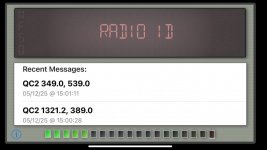Hi everyone,
I’m reaching out to see if anyone here might be able to assist me with identifying the two-tone alert tones (Tone A and Tone B) used by the Rural/Metro Fire Department in the Tucson, Arizona area. I’ve attached an audio clip that contains what I believe is the actual alerting tones used during dispatch, and I’m hoping someone with the right tools or experience can help me determine the exact frequencies.
Unfortunately, I don’t have the decoding equipment necessary to analyze the tones myself. I’m relatively new to working with pagers and two-tone alerting, and I don’t currently have access to a decoder or software that can accurately read and measure these tones from the audio. What I do have is a Unication G5 pager, and my goal is to program it so that I can receive and monitor Rural/Metro dispatches properly.
If anyone is familiar with the tone pairs Rural/Metro uses, or if you’re able to analyze the audio and determine the tone frequencies, I would be extremely grateful for your help. Even just pointing me in the right direction would be appreciated.
Additionally, I’d be interested to know if there’s a known VHF frequency or channel that Rural/Metro Fire typically uses for dispatch or fireground operations. I’ve been researching online and scanning local frequencies, but I haven’t been able to confidently identify which ones are active for this department.
If it helps, I’m located in the Tucson area, so this is specific to Southern Arizona operations – not Phoenix or Maricopa County.
Thank you in advance to anyone who can offer advice, guidance, or technical assistance. I know this community has a wealth of knowledge, and I appreciate the time you take to help folks like me get started and get set up properly.
Looking forward to hearing from you.
– Max


